Kashi Vishwanath Temple: The Abode of Timeless Divinity
Kashi Vishwanath is more than a temple. It is a living prayer, an eternal light, and the very breath of spirituality.
In the heart of Varanasi, the world's oldest living city, where spirituality drips from every corner, stands the Kashi Vishwanath Temple—a beacon of faith and liberation. Dedicated to Lord Shiva, the Destroyer and Transformer, the temple is not merely a shrine but a portal where earthly existence touches the eternal.
Perched gracefully on the western banks of the sacred Ganges River, this Jyotirlinga—one of the 12 luminous manifestations of Lord Shiva—has been the spiritual heartbeat of Hinduism for centuries. It draws millions of devotees who come seeking peace, liberation (moksha), and a connection to the divine.
The Eternal Jyotirlinga: A Beacon of Light
Kashi Vishwanath is not just a temple—it is one of the 12 Jyotirlingas, revered as luminous manifestations of Lord Shiva. The term Jyotirlinga signifies the "pillar of light" that connects earth to the divine cosmos. As the myth goes, the Lord himself chose Kashi as his earthly residence, whispering to humanity that Varanasi is the path to liberation—Moksha. The temple stands as an eternal flame, never dimming, guiding pilgrims through the darkness of illusion (Maya) into the light of truth.
A Journey Through History: The Eternal Resilience of Kashi Vishwanath
The Kashi Vishwanath Temple has endured centuries of transformation, rising and falling with the tides of time, invasions, and restoration. Its historical timeline reflects not just the story of a temple but the resilience of faith itself:
Ancient Times: The exact origin of the Kashi Vishwanath Temple is shrouded in mystery, with references to it appearing as early as the Puranic texts and the Skanda Purana. Lord Shiva is believed to have made Kashi his earthly abode, granting liberation to all who reside here.
11th Century: The temple faced the first recorded destruction under Qutb-ud-din Aibak, the commander of Muhammad Ghori.
1585 AD: The temple was rebuilt under Raja Todar Mal, a trusted courtier of Emperor Akbar, at the request of Hindu saints and scholars.
1669 AD: Aurangzeb, the Mughal emperor, ordered the demolition of the temple, replacing it with the Gyanvapi Mosque, which still stands adjacent to the temple.
1777–1780 AD: The present structure was commissioned by Maharani Ahilyabai Holkar of Indore, a great patron of temples across India, who restored the sanctity of the temple. She also adorned it with the finest craftsmanship of the era.
1835 AD: Maharaja Ranjit Singh, the king of Punjab, donated 1 ton of gold to gild the temple's spire, which now gleams as a symbol of divine radiance.
Modern Day: Today, the Kashi Vishwanath Temple stands tall as a revered site of devotion, embraced by the faithful and preserved as a cultural heritage by the Indian government.
The Spiritual Embrace of Kashi
To step into the Kashi Vishwanath Temple is to transcend the ordinary. The sound of "Har Har Mahadev" reverberates through the air, blending with the gentle hum of bells and chants that seem to awaken the sleeping soul. As the golden spire glistens under the morning sun, devotees bow their heads in reverence, offering their prayers with faith that flows like the sacred Ganga herself—pure, unwavering, and eternal.
The Ganges, a river that purifies even the gravest sins, runs in quiet devotion alongside the temple. It is believed that Lord Shiva whispers the Taraka Mantra (liberation chant) into the ears of those who take their last breath in Kashi, promising freedom from the cycle of life and death.
Kashi Vishwanath Temple is not just a pilgrimage destination but a way of life for Varanasi's residents and the countless pilgrims who visit daily. It embodies the spirit of Shiva—the eternal ascetic and the universal protector—whose presence in Kashi sanctifies every moment.
Spiritual Practices:
Mangal Aarti at dawn welcomes Lord Shiva with prayers and chants.
Rudrabhishek (ritual bath) is performed by priests to honor the Jyotirlinga.
Devotees chant the Mahadev Mantra: "Har Har Mahadev", believed to cleanse the soul.
The Ganges Connection:
Pilgrims often bathe in the Ganges before entering the temple, symbolizing the purification of body and spirit. It is believed that this union of river and shrine amplifies the blessings of Lord Shiva.Spiritual Festivals:
Maha Shivratri: The grandest festival celebrated here with unparalleled fervor, as devotees observe fasts and sing praises to Shiva throughout the night.
Shravan Maas (July-August): The holy month of Shiva, where thousands flock to offer Gangajal (sacred water) to the deity.
Daily Routine: The temple's rhythm echoes in the hearts of Varanasi's people—from the early chants to the evening Ganga Aarti performed on the riverbanks.
A Tapestry of Ancient Mysticism
The Kashi Vishwanath Temple carries within its walls the weight of millennia. Destroyed and rebuilt multiple times, it symbolizes resilience and faith, standing tall as a testament to spiritual devotion. From Adi Shankaracharya to Tulsidas, countless saints have walked this sacred soil, leaving behind echoes of their enlightenment.
Here, time ceases to exist. It is said that Kashi rests at the center of the universe—"Shiva’s city", where the material meets the metaphysical, and where every prayer resonates with the hum of creation itself.
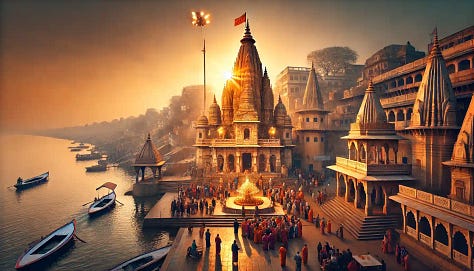
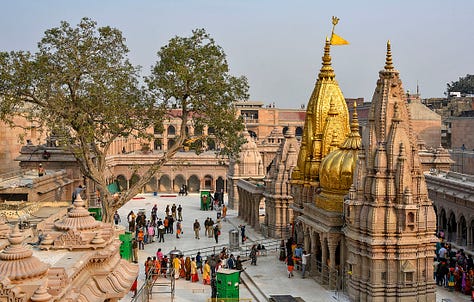
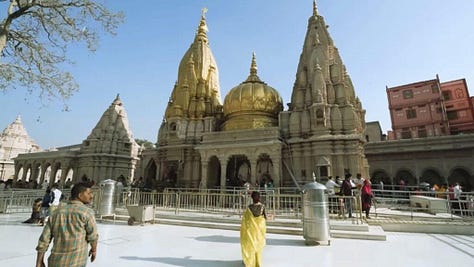
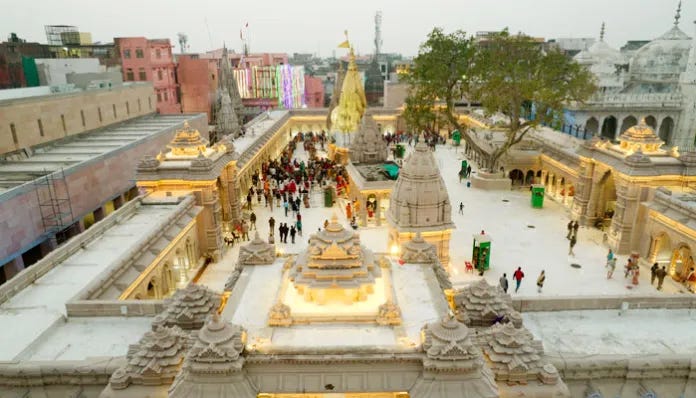
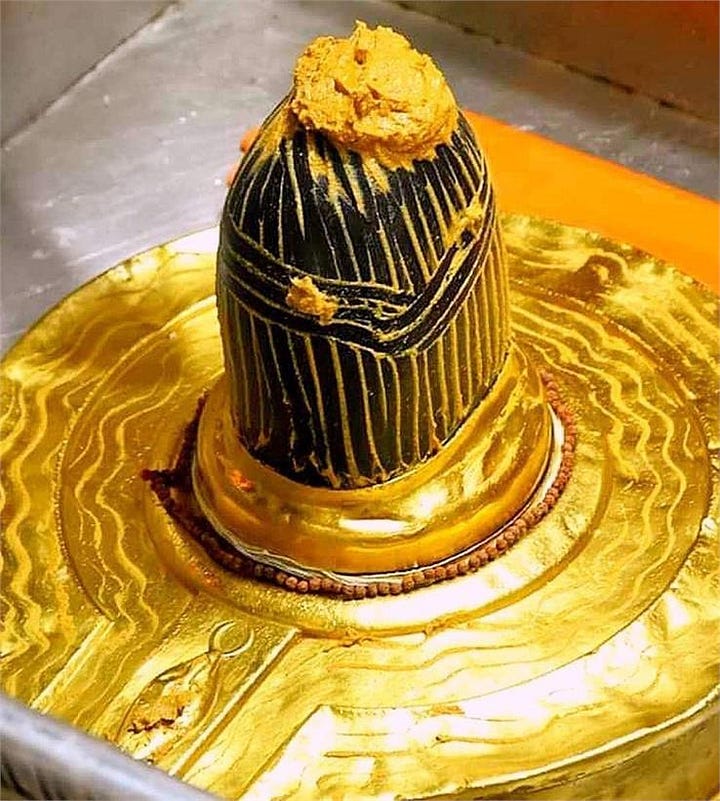
What to Do at Kashi Vishwanath Temple
Attend the Aartis:
Mangal Aarti (4 AM): The temple opens with this pre-dawn ritual.
Bhog Aarti (11:15 AM): Offering food to the deity.
Sandhya Aarti (7 PM): An enchanting evening ritual.
Shayan Aarti (10:30 PM): The final worship before the deity "rests."
Rudrabhishek Puja:
Participate in this special puja, where devotees anoint the Jyotirlinga with milk, honey, and holy water, accompanied by chants.Visit the Gyanvapi Well:
This sacred well within the complex holds historical significance and is believed to house the original Jyotirlinga.Stroll along the Ghats:
After visiting the temple, take a peaceful walk along the Ghats of the Ganges. Witness the vibrant Ganga Aarti at Dashashwamedh Ghat in the evening.Explore Varanasi’s Alleys:
The temple is surrounded by bustling streets lined with shops selling rudraksha beads, banarasi silk, and prasad (offering).
When to Visit
Best Time: The cooler months from October to March offer the most pleasant weather.
Spiritual Peaks:
Maha Shivratri (February/March)
Shravan Maas (July-August)
Daily Hours: The temple opens at 3 AM and closes around 11 PM. Arrive early to avoid crowds and to experience the serenity of the Mangal Aarti.
Travel Tips for Pilgrims
Dress Modestly: Traditional Indian attire is encouraged.
Avoid Rush Hours: Early mornings and late evenings offer peaceful darshans.
Prasad and Offerings: Purchase flowers and offerings from the designated vendors near the temple.
Secure Valuables: The temple follows strict security; cameras, phones, and large bags are not allowed inside.
Accommodation: Stay near the Ghats for easy access to the temple and the Ganga Aarti.
A Journey Within
To visit Kashi Vishwanath is not merely a pilgrimage—it is a journey within. It is where the ego dissolves, where the boundaries of identity fade, and where the soul remembers its eternal connection to the divine. As you stand before the Jyotirlinga, drenched in devotion, a profound silence fills your being, whispering the ancient truth:
"You are not separate from the divine; you are the divine."
In Kashi, Shiva reigns not just in stone but in every heart that surrenders to him. The experience is not merely seen or heard—it is felt, and it lingers, reminding us that the path to liberation is through faith, surrender, and love.
The Kashi Vishwanath Temple is more than just a place of worship; it is the axis where faith, history, and divinity intersect. It whispers the timeless truth of Lord Shiva: "The soul is eternal, untouched by death or decay."
To visit Kashi is to step into the timeless embrace of Lord Vishwanath—the "King of the Universe"—who promises liberation to all who call upon him. The experience lingers far beyond the visit, filling the heart with peace, humility, and a sense of the divine within.
As the chants of "Har Har Mahadev" rise with the morning sun and dissolve into the sacred Ganges, one thing becomes clear: Kashi is not just a city, and Vishwanath is not just a temple—they are eternal gateways to the divine.


